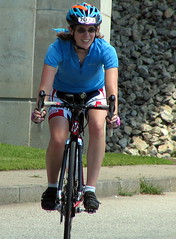Question: What’s the best thing you can do on a Thursday in February?
Answer: Come to Olympia with fellow cycling advocates to make a difference.
It’s not too early to mark your calendar for one of the upcoming legislative session’s most important days for supporters of bicycling, walking, transit, and the environment: Thursday, February 10, Transportation Advocacy Day.
That’s the day that the Bicycle Alliance and other groups promoting transportation choices beyond he automobile will travel to the state capital to meet with lawmakers, attend legislative hearings, and learn more about the transportation policy issues that face our state.
Operating under the umbrella of the
Transportation Choices Coalition, those participating in the day’s lobbying and other activities also include organizations such as Futurewise, the Sierra Club Cascade Chapter, the Cascade Bicycle Club, Feet First, and the Washington State Parks and Recreation Association.
The 2011 legislative session will be tough, with the state facing a continuing budget crisis and interest groups across the board clamoring for attention and money. In politics there’s strength in numbers, and it’s important to show legislators that there’s a strong constituency supporting cycling, walking and transit.
Among other things, Transportation Advocacy Day will be a good opportunity to promote the Bicycle Alliance’s 2011 legislative priorities. The priorities were developed by our Legislative Committee, made up of representatives from supporting bicycle clubs and communities from around the state. As adopted by our Board, the 2011 lobbying priorities include:
· Traffic safety education—require that the driving schools attended by motorists who have received a traffic ticket teach the Department of Licensing’s approved curriculum for safe driving around cyclists and pedestrians.
· Mutual courtesy and safe passing—clarify the laws that define safe and courteous behavior for cyclists and motorists, including legislation governing how much space motorists should give cyclists when passing alongside them.
· Complete streets—create a framework for a grant program to create incentives for communities that adopt a “complete streets” policy to ensure that their streets are designed and built to accommodate cycling and walking.
· Lower speed limits—Give communities broader authority to lower speed limits to 20 miles an hour in neighborhoods with high pedestrian and bicycle traffic. Studies in Europe have shown that lower speed limits sharply reduce injuries and death.
· Liability—Impose reasonable limits on the liability of communities that sign bicycle routes or produce bike maps. Currently, some communities don’t mark or map routes at all because they fear they will be found liable for injuries suffered by cyclists who use the routes.
In addition to its main priorities, the Bicycle Alliance also supports legislation to better protect vulnerable road users such as cyclists and pedestrians, require the State to include the external costs of driving when assessing projects, and provide adequate funding for cycling and walking.
Come to Olympia and make a difference! You can sign up for Transportation Advocacy Day by visiting the Transportation Choices Coalition
website. You can also learn more about legislative issues important to cyclists by visiting the Bicycle Alliance’s legislative issues
webpage, which includes regular updates and action alerts during the legislative session.
In the meantime, cycling advocates can get a jump-start on the session by
contacting their legislators to introduce themselves and ask for support of the Bike Alliance’s legislative priorities.
 |
| (From Kevin P's Flickr photostream) |















































